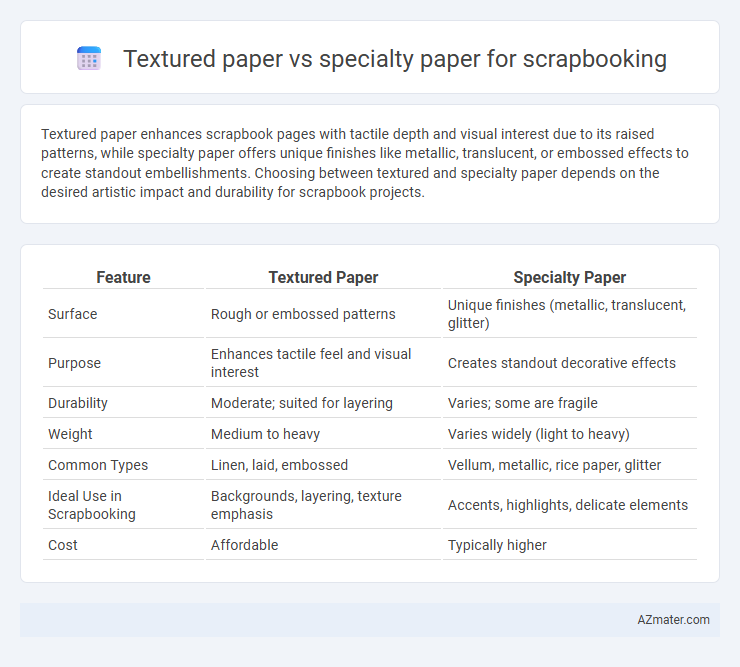Textured paper enhances scrapbook pages with tactile depth and visual interest due to its raised patterns, while specialty paper offers unique finishes like metallic, translucent, or embossed effects to create standout embellishments. Choosing between textured and specialty paper depends on the desired artistic impact and durability for scrapbook projects.
Table of Comparison
| Feature | Textured Paper | Specialty Paper |
|---|---|---|
| Surface | Rough or embossed patterns | Unique finishes (metallic, translucent, glitter) |
| Purpose | Enhances tactile feel and visual interest | Creates standout decorative effects |
| Durability | Moderate; suited for layering | Varies; some are fragile |
| Weight | Medium to heavy | Varies widely (light to heavy) |
| Common Types | Linen, laid, embossed | Vellum, metallic, rice paper, glitter |
| Ideal Use in Scrapbooking | Backgrounds, layering, texture emphasis | Accents, highlights, delicate elements |
| Cost | Affordable | Typically higher |
Introduction to Scrapbook Paper Choices
Scrapbook paper choices significantly impact the aesthetic and tactile appeal of your projects, with textured paper offering a rich, dimensional feel that enhances visual interest. Specialty paper encompasses unique finishes such as foil, vellum, or glitter, providing distinct effects for creative accents and embellishments. Selecting the right paper type depends on desired design elements and project durability, ensuring your scrapbook reflects personal style and craftsmanship.
What is Textured Paper?
Textured paper in scrapbooking features raised or embossed surfaces that add tactile dimension and visual interest, often mimicking natural materials like linen or canvas. Its varied textures enhance photos and embellishments by providing depth and contrast, making each scrapbook page more dynamic and engaging. Selecting textured paper can elevate the artistic appeal of a scrapbook, distinguishing it from standard smooth or specialty papers designed for unique finishes or specific effects.
What is Specialty Paper?
Specialty paper in scrapbooking refers to unique, high-quality materials designed to enhance creative projects with distinct textures, finishes, or embedded elements such as glitter, foil, or embossing. Unlike standard textured paper, which primarily focuses on surface feel and pattern, specialty paper offers a wide range of artistic effects and durability tailored for artistic embellishments. These papers are ideal for adding depth and personalized flair to scrapbook pages, making each layout visually striking and tactilely engaging.
Key Differences: Textured vs Specialty Paper
Textured paper features raised patterns that add tactile dimension and visual interest to scrapbook pages, enhancing the sensory experience with surfaces like linen or canvas. Specialty paper includes unique materials such as metallic, vellum, or handmade paper, offering distinct finishes and effects beyond standard textures. The key difference lies in textured paper emphasizing surface feel and design, while specialty paper focuses on material composition and innovative aesthetics.
Visual Impact on Scrapbook Designs
Textured paper enhances scrapbook designs by adding tactile depth and dimension, creating a more dynamic and engaging visual experience. Specialty paper, such as metallic or vellum, offers unique finishes and translucency that elevate the aesthetic appeal with sophisticated effects. Combining textured and specialty papers maximizes visual interest, transforming simple layouts into striking, multi-layered artwork.
Durability and Handling
Textured paper offers enhanced durability with a thicker surface that resists tearing and handles adhesives well, making it ideal for long-lasting scrapbook projects. Specialty paper, such as metallic or vellum, provides unique aesthetics but can be more delicate and prone to damage when layered or manipulated extensively. Selecting textured paper improves overall scrapbook resilience and ease of handling during cutting, folding, and gluing.
Compatibility with Craft Tools
Textured paper offers excellent compatibility with embossing tools, stamps, and ink pads due to its raised surface that holds ink well and adds dimension. Specialty paper, such as metallic or vellum, requires compatible adhesives and cutting tools to prevent damage or smudging, often benefiting from craft knives and heat-resistant adhesives. Both paper types demand specific tools for optimal results, with textured paper favoring stamping and embossing and specialty paper requiring precision cutting and gentle handling.
Cost Comparison
Textured paper for scrapbooking generally offers a lower-cost option compared to specialty paper due to its widespread availability and simpler manufacturing process. Specialty paper, often made with unique fibers, metallic finishes, or embossing, tends to have a higher price point reflecting its premium quality and limited production. Cost-conscious scrapbookers may prefer textured paper to maximize volume while those seeking distinctive aesthetics will invest in specialty paper despite the higher expense.
Best Uses for Textured and Specialty Papers
Textured paper enhances scrapbooking projects by adding tactile dimension and visual interest, making it ideal for backgrounds, borders, and layering elements that require depth and richness. Specialty paper, including metallic, vellum, or embossed variants, excels in highlighting focal points, embellishments, and accent pieces due to its unique finishes and effects. Choosing textured paper benefits layouts requiring subtle texture, while specialty paper suits creative accents that demand distinct visual impact.
Tips for Choosing the Right Paper for Your Scrapbook
Textured paper enhances scrapbook pages with tactile dimension and visual interest, making it ideal for adding depth to backgrounds and embellishments. Specialty paper offers unique finishes such as metallic, vellum, or embossed designs, perfect for highlighting focal points and creating a polished look. When choosing the right paper for your scrapbook, consider the page layout, adhesive compatibility, and the durability required to ensure long-lasting and visually appealing results.

Infographic: Textured paper vs Specialty paper for Scrapbook
 azmater.com
azmater.com